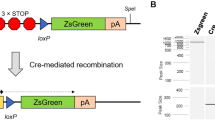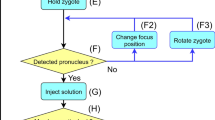Abstract
Although the laboratory rat (Rattus norvegicus) is an indispensable experimental animal for biomedical research and drug development, the lack of embryonic stem cell lines hampers gene-knockout studies. Here we report the successful generation of insertional mutant rats using the Sleeping Beauty (SB) transposon system. This would benefit a variety of biomedical research fields for which the rat model is better suited than the mouse model.
This is a preview of subscription content, access via your institution
Access options
Subscribe to this journal
Receive 12 print issues and online access
$259.00 per year
only $21.58 per issue
Buy this article
- Purchase on Springer Link
- Instant access to full article PDF
Prices may be subject to local taxes which are calculated during checkout



Similar content being viewed by others
References
Carlson, C.M. & Largaespada, D.A. Nat. Rev. Genet. 6, 568–580 (2005).
Luo, G., Ivics, Z., Izsvak, Z. & Bradley, A. Proc. Natl. Acad. Sci. USA 95, 10769–10773 (1998).
Horie, K. et al. Proc. Natl. Acad. Sci. USA 98, 9191–9196 (2001).
Fischer, S.E., Wienholds, E. & Plasterk, R.H. Proc. Natl. Acad. Sci. USA 98, 6759–6764 (2001).
Dupuy, A.J., Fritz, S. & Largaespada, D.A. Genesis 30, 82–88 (2001).
Horie, K. et al. Mol. Cell. Biol. 23, 9189–9207 (2003).
Ivics, Z., Hackett, P.B., Plasterk, R.H. & Izsvak, Z. Cell 91, 501–510 (1997).
Keng, V.W. et al. Nat. Methods 2, 763–769 (2005).
Yin, Y., Sanes, J.R. & Miner, J.H. Mech. Dev. 96, 115–119 (2000).
Grieshammer, U. et al. Dev. Cell 6, 709–717 (2004).
Gibbs, R.A. et al. Nature 428, 493–521 (2004).
Zan, Y. et al. Nat. Biotechnol. 21, 645–651 (2003).
Dupuy, A.J., Akagi, K., Largaespada, D.A., Copeland, N.G. & Jenkins, N.A. Nature 436, 221–226 (2005).
Collier, L.S., Carlson, C.M., Ravimohan, S., Dupuy, A.J. & Largaespada, D.A. Nature 436, 272–276 (2005).
Acknowledgements
We thank P. B. Hackett (University of Minnesota) for providing SB cassettes.
Author information
Authors and Affiliations
Corresponding author
Ethics declarations
Competing interests
The authors declare no competing financial interests.
Supplementary information
Supplementary Fig. 1
Lethality of Stch homozygous mutants revealed by testcross analysis.
Supplementary Table 1
Summary of the trapped genes in this study.
Supplementary Table 2
Summary of additional transposition sites.
Rights and permissions
About this article
Cite this article
Kitada, K., Ishishita, S., Tosaka, K. et al. Transposon-tagged mutagenesis in the rat. Nat Methods 4, 131–133 (2007). https://doi.org/10.1038/nmeth1002
Received:
Accepted:
Published:
Issue Date:
DOI: https://doi.org/10.1038/nmeth1002
This article is cited by
-
Expression dynamics and relations with nearby genes of rat transposable elements across 11 organs, 4 developmental stages and both sexes
BMC Genomics (2017)
-
Long Evans rat spermatogonial lines are effective germline vectors for transgenic rat production
Transgenic Research (2017)
-
2015 Guidelines for Establishing Genetically Modified Rat Models for Cardiovascular Research
Journal of Cardiovascular Translational Research (2015)
-
CRISPR/Cas-mediated genome editing in the rat via direct injection of one-cell embryos
Nature Protocols (2014)
-
Generation of minipigs with targeted transgene insertion by recombinase-mediated cassette exchange (RMCE) and somatic cell nuclear transfer (SCNT)
Transgenic Research (2013)



